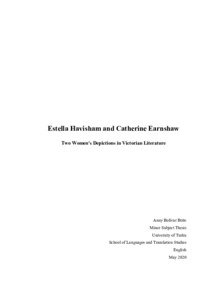Estella Havisham and Catherine Earnshaw : Two Women's Depictions in Victorian Literature
Bolivar Brito, Anny (2020-06-08)
Estella Havisham and Catherine Earnshaw : Two Women's Depictions in Victorian Literature
Bolivar Brito, Anny
(08.06.2020)
Julkaisu on tekijänoikeussäännösten alainen. Teosta voi lukea ja tulostaa henkilökohtaista käyttöä varten. Käyttö kaupallisiin tarkoituksiin on kielletty.
avoin
Julkaisun pysyvä osoite on:
https://urn.fi/URN:NBN:fi-fe2020062946225
https://urn.fi/URN:NBN:fi-fe2020062946225
Tiivistelmä
This paper compares women's depiction through the main female character in Great Expectations by Charles Dickens and Wuthering Heights by Emily Brontë with the lens of the Feminist theory. The qualitative nature of the research assists in the analyses of women's education, role, and interaction as key elements to understand the domesticity represented in these two Victorian classics of the nineteenth-century literature. It is claimed that Charles Dickens in Great Expectations challenges the patriarchal state that confines women to a domestic life whilst Emily Brontë in Wuthering Heights uses domestic ideologies to portray her female heroine, respecting the values and norms of a male-dominated society. The study demonstrates the tendency of Dickens to give his main character with unique situations where opportunities of female empowerment and self-growth are provided. In contrast, Brontë represents her central character as a heroine in distress who is not only punished with her inability as a woman to choose her own fate but also goes through constant suffering that keeps her in a physical and mental submission. Throughout the analysis of the premises, questions in regard to authors' intentions and limitations emerged, which are yet to be studied in future researches.
